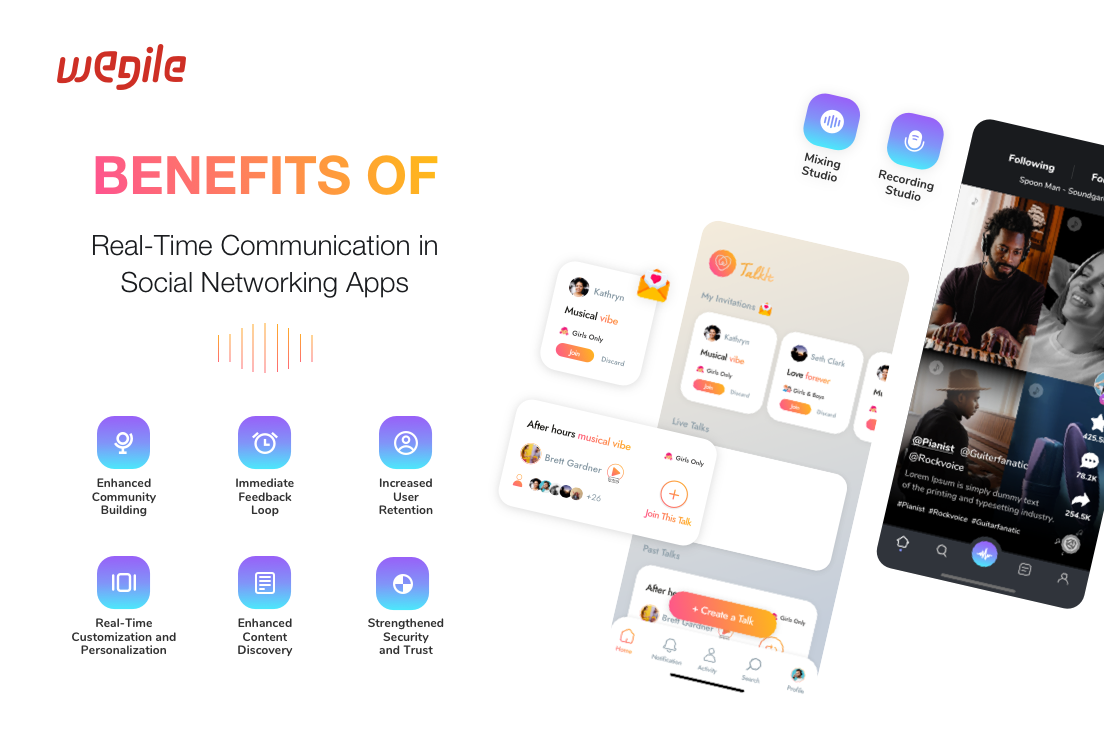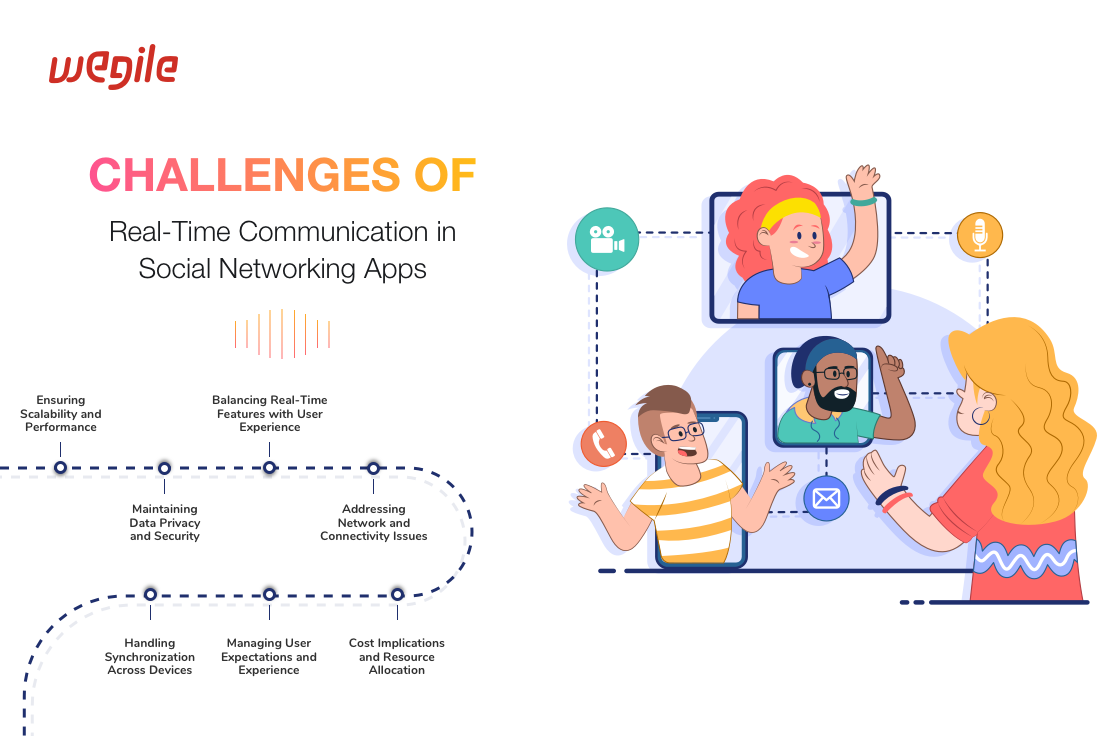Social networking apps are at the forefront, consistently reshaping the ways we connect, share, and engage with each other. At the core of this transformative journey is the rise of real-time communication—a feature that has evolved from something of a luxury to a daily activity for users. In addition to instant messaging, real-time communication encompasses a diverse range of live interactions, including video streams that overcome geographical limitations and updates that follow the fast-paced nature of everyday life. This article aims to explore the intricate details of real-time communication within social networking platforms, investigating the deeper aspects that influence user experiences beyond the surface-level advantages. In this blog, we will explore how real-time communication molds our digital and interpersonal landscapes.
Real-time communication (RTC) signifies a significant change in the way social interactions on the Internet are conducted. RTC is centered around technologies that facilitate instant information exchange, creating an environment where conversations and content sharing flow smoothly, similar to in-person interactions. RTC goes beyond the usual digital interaction by eliminating the delay that used to be an integral part of electronic exchanges. This sense of immediacy goes beyond mere speed. It's about fostering a synchronized atmosphere where users can actively participate in real-time interactions, be it through text, voice, or video. The core of RTC is its capacity to harmonize user experiences, rendering distances practically insignificant and revolutionizing our perception of connectivity in the digital world.
The technology behind RTC involves an advanced collaboration of protocols and architectures, like WebRTC (Web Real-Time Communication). This results in direct, peer-to-peer communication within web browsers, removing the need for intermediaries or extra plugins. The widespread adoption of real-time capabilities in social media apps is due to the accessibility of these features, which prioritize immediate interaction. In addition, the continuous development of cloud infrastructure and edge computing has greatly minimized latency, resulting in an even better real-time communication experience. Real-time communication has completely transformed the way we engage on social platforms, establishing a fresh comparison for instantaneity and interconnectedness.
Some of the popular sources of real-time communication in social media apps are:
Instant Messaging allows users to send text messages instantly back and forth. This tool supports fast-paced, text-based communication, enhancing connectivity by allowing users to exchange thoughts and information in real-time.
Video conferring enables face-to-face interaction from virtually anywhere in the world. This method is vital for personal conversations, business meetings, or virtual hangouts, providing a sense of presence and personal touch despite physical distance.
With live streaming, users can broadcast video content in real-time, engaging with an audience as events unfold. This method is particularly popular for live tutorials, gaming, events, and more, allowing interaction through comments and reactions during the broadcast.
The voice calling feature in social media apps Facilitates real-time voice communication between users. Similar to traditional phone calls but over the internet, this feature helps maintain personal connections without the need for text-based messaging.
In real-time communication within social media apps, understanding the concepts of half and full duplex is crucial for optimizing interactions. Half-duplex communication allows data to travel in both directions on a signal carrier but not at the same time. For instance, in a walkie-talkie-like scenario within an app, a user must wait for the other to finish speaking before responding, making it suitable for certain types of controlled communication environments where bandwidth is limited.
Conversely, full duplex communication supports simultaneous data transmission in both directions, akin to a telephone conversation. This method is essential for live video conferencing or voice calls on social media, where seamless, real-time interaction is paramount. The ability to transmit and receive data simultaneously without waiting enhances the user experience by making digital interactions feel as natural and fluid as in-person conversations. Full duplex systems are more complex and require sophisticated management of signal paths and bandwidth to ensure clarity and delay-free communications.
| Technology | Description | Use Case |
| WebRTC | A free and open-source project that lets web browsers and mobile apps talk to each other in real time using simple APIs. | Enables video and audio communication directly in the browser without the need for additional plugins or software. Commonly used for video chats and peer-to-peer sharing. |
| WebSocket | A protocol for establishing full-duplex communication channels through a solitary TCP connection. | Used for continuous data exchange between a client and a server, ideal for chat applications and live sports updates where low latency is crucial. |
| SignalR | A library for ASP.NET developers that simplifies the process of adding real-time web functionality to applications. | Facilitates real-time bi-directional communication between server and client, enabling features like live chat and real-time updates for collaborative applications. |
| MQTT | The lightweight messaging protocol offers a straightforward means for resource-constrained network clients to distribute telemetry information. | Often implemented in mobile environments where bandwidth and battery power are at a premium, perfect for real-time IoT device updates. |
| XMPP (Jabber) | An open, extensible messaging and presence protocol designed for real-time communication. | Supports messaging, presence information, and contact list maintenance, commonly used in the backend of many messaging services for instant communication. |
| SIP (Session Initiation Protocol) | A lightweight messaging protocol that facilitates the distribution of telemetry data for network consumers with limited resources. | Commonly used for video conferencing and direct instant messaging connections, as well as controlling multimedia communication sessions. |
| Push Technology | A method of internet-based communication where the request for a transaction is initiated by the publisher or central server. | Utilized for sending real-time notifications and updates to users' devices, keeping them informed about new messages or events immediately. |

Real-time communication fosters a sense of belonging and community among users. In social networking apps, features like group chats, live streaming, and real-time reactions enable users to connect and engage over shared interests and events as they happen. This immediacy creates a vibrant, dynamic community atmosphere that can't be replicated through delayed interactions. By participating in real-time discussions and events, users can form stronger bonds and feel more integrated into the community, enhancing their overall experience and loyalty to the platform.
One of the key benefits of real-time communication is the creation of an immediate feedback loop between users and content creators. Whether it's comments on a post, reactions to a live video, or responses in a chat, real-time interaction allows for instant engagement. This further enriches the user experience by making it interactive and responsive and also provides valuable insights for content creators and platform administrators. Understanding user reactions and preferences in real time enables quicker adjustments and more targeted content creation, leading to a more engaging and user-centric platform.
Also Read: How to Make a Social Media AppReal-time communication capabilities are crucial for keeping users engaged and invested in a social networking app. The instant nature of these interactions ensures that users are continually drawn back to the platform, whether it's for a quick chat, to check on updates from their network, or to participate in live events. This constant engagement helps to significantly reduce churn rates as users find more value and utility in the platform, making it an integral part of their daily routines. This results in a loyal user base that sustains the platform and contributes to its growth through increased activity and new user referrals.
Real-time communication enables platforms to offer highly customized and personalized user experiences. By analyzing user interactions and preferences in real-time, social networking apps can dynamically adjust content, recommendations, and notifications to suit individual user needs. This level of personalization enhances user satisfaction, as the content feels more relevant and engaging, encouraging further interaction with the app. Personalized real-time alerts about friend activities, events, or topics of interest ensure that users are always connected to what matters most to them, making the social networking experience deeply integrated into their personal and social lives.
The integration of real-time communication in social networking apps significantly improves content discovery mechanisms. Live feeds, trending topics, and real-time recommendations keep the content landscape fresh and engaging. Users are more likely to encounter new content that resonates with their interests, leading to increased exploration within the app. This not only enriches the user experience but also provides content creators and advertisers with a more dynamic and responsive platform for content distribution and engagement, boosting visibility and interaction rates for new and relevant content.
In the context of social networking, real-time communication can also play a pivotal role in enhancing security and building trust among users. Real-time alerts and notifications about account activity, such as new logins or changes to account settings, can help users quickly detect and respond to unauthorized access or potential security threats. Additionally, the ability to report and receive immediate support or feedback on issues related to content or interactions within the app strengthens the trust users have in the platform's commitment to their safety and well-being. This immediate support and responsiveness are crucial for maintaining a secure and trustworthy environment, which is essential for user retention and the platform's reputation.

One of the paramount challenges in implementing real-time communication features in social networking apps is ensuring scalability and performance. As the user base grows, the infrastructure must efficiently manage an increasing volume of simultaneous real-time interactions without lag or downtime. This requires robust backend architecture and innovative solutions like load balancing, efficient data handling, and choosing the right framework for social media apps to maintain smooth and responsive communication channels, even during peak usage times.
Integrating real-time communication raises significant concerns about data privacy and security. Each message, video call, or shared update increases the risk of data breaches and unauthorized access. Social networking apps must implement stringent security measures, such as end-to-end encryption for messages and calls, secure data storage practices, and regular security audits to protect user information. Additionally, compliance with international data protection regulations, like GDPR, adds another layer of complexity, requiring constant vigilance and updates to privacy policies and security protocols.
While real-time communication enhances user engagement, it also poses the challenge of integrating these features without cluttering the app interface or overwhelming users with notifications. Designing an intuitive user interface that seamlessly incorporates real-time interactions, such as chat windows, live video streams, and notifications, requires a deep understanding of user behavior and preferences. The aim is to offer a clean, user-friendly experience that makes real-time features accessible and enjoyable without detracting from the overall usability of the app.
Real-time communication heavily relies on stable and fast internet connectivity. Users in areas with poor network coverage or those using low-bandwidth connections may experience delays, interruptions, or lower-quality interactions. Social networking apps need to optimize real-time communication features to function effectively across varying network conditions, possibly incorporating adaptive bitrates for live streaming or offline capabilities for messaging to ensure that all users can participate in real-time interactions regardless of their connectivity situation.
Ensuring that real-time communication is synchronized across multiple devices poses a significant technical challenge. Users often switch between smartphones, tablets, and desktops, expecting seamless transition and continuity in their communication. Achieving this requires sophisticated synchronization mechanisms that can handle real-time data across diverse platforms and operating systems, ensuring that messages, notifications, and content updates are consistently reflected, no matter the device in use.
The integration of real-time communication features comes with heightened user expectations for instant gratification and uninterrupted service. Any delay, be it in message delivery, notification updates, or live streaming, can significantly impact user satisfaction. Meeting these expectations requires not just robust technical infrastructure but also effective user experience design that can gracefully handle potential issues like server latency or downtime, ensuring that user experience remains positive even when technical challenges arise.
Implementing and maintaining real-time communication features can be resource-intensive, leading to increased operational costs. These costs stem from the need for high-performance servers, data transfer expenses, development and maintenance of the communication infrastructure, and compliance with security and privacy standards. Balancing the financial investment against the value added to the user experience is a crucial challenge, requiring careful planning and optimization to ensure that the benefits of real-time communication justify the costs involved.
The future landscape of real-time communication in social media apps is poised for transformative growth, driven by advancements in AI and machine learning. Enhanced predictive analytics will improve the personalization of interactions, making them more contextually relevant and timely. Integration of 5G technology will further reduce latency, facilitating smoother, more reliable communication experiences akin to real-world conversations.
Also, as AR and VR technologies mature, we'll see more immersive communication environments that replicate physical presence, offering users novel ways to connect and engage. The blend of these technologies will not only redefine user expectations but also elevate the standards of interaction, making real-time communication more intuitive, seamless, and engaging.
At Wegile, we understand the intricacies and challenges of integrating real-time communication into social networking apps. Our expertise in developing cutting-edge social media applications positions us as your ideal partner in this journey. We specialize in crafting solutions that are not only technologically advanced but also deeply attuned to the needs of your users, enhancing engagement and fostering a vibrant community.
Our approach involves a meticulous analysis of your specific requirements and the unique dynamics of your target audience. This ensures that the solutions we provide are tailor-made to fit your objectives, whether it's scaling to accommodate a growing user base, implementing robust security measures to protect user data, or delivering a seamless user experience that keeps your audience coming back for more.
With our social media app development company, you're not just getting a service provider; you're partnering with a team that's committed to your success. We bring to the table a wealth of experience, a commitment to excellence, and a deep understanding of the social networking domain, ensuring that your app not only meets the current standards but also sets new benchmarks in user engagement and satisfaction.
In conclusion, real-time communication is not just a feature but the backbone of user engagement and interaction in social networking apps. Its ability to connect users instantly, foster community building, and deliver personalized content makes it indispensable in today's digital age. However, integrating these features comes with its set of challenges, from ensuring scalability to maintaining privacy and security. At Wegile, we are dedicated to navigating these complexities, offering tailored solutions that enhance user experience and engagement. By partnering with us, you leverage our expertise to create a social networking app that not only meets but exceeds user expectations, setting new standards in the digital landscape.


 Browse Our Services
Browse Our Services
